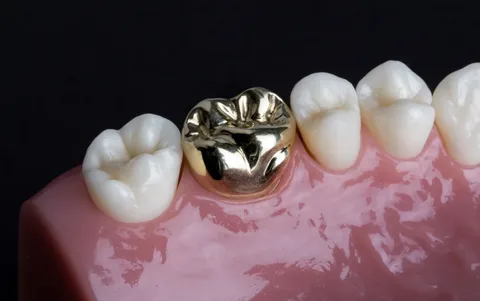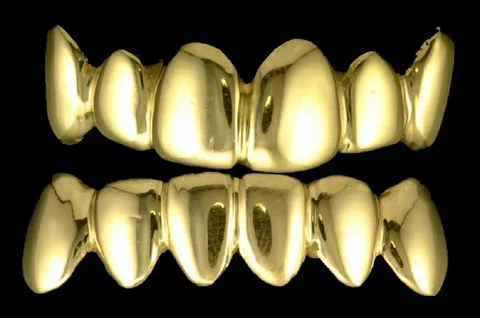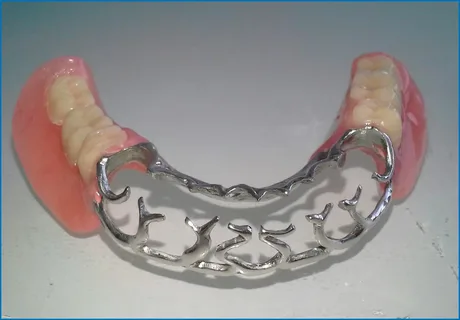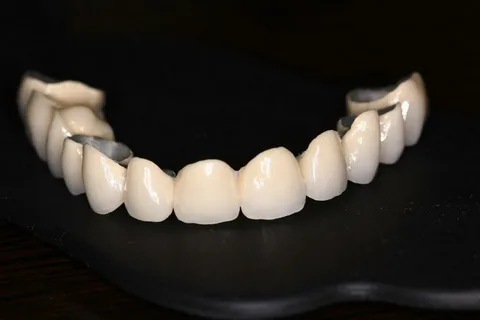The use of metals in orthopedic dentistry
Machine translation
Original article is written in RU language (link to read it).
In its pure form, no metal is used in orthopedic dentistry, only in the form of metal alloys. It is impossible to use pure metals because their characteristics do not meet the requirements for structural materials. Their strength in their pure form is low, they are susceptible to corrosion, and have poor physical and mechanical properties.
About the laboratory stages of manufacturing bridges at the webinar Analog and digital laboratory protocols for the manufacture of metal-ceramic restorations using the vertical preparation method .
Multicomponent alloys are widely used in dental prosthetics. And all thanks to their unique physical and mechanical characteristics:
they are not susceptible to corrosion;
have the required melting point;
characterized by insignificant volumetric shrinkage;
can be malleable and elastic.

Figure 1. Metal crown.
The formation of such alloys is based on the ability of individual metals to dissolve mutually and the formation of chemical bonds between them.
Gold alloys
Natural gold is a rather soft metal, which in its pure form cannot be used in orthopedic dentistry. But if you add certain components to gold in a certain ratio, an alloy is formed that has the necessary characteristics to make a denture.
Different alloys are used in dentistry, all of them differ in gold content. It is worth noting that pure gold is 1000 fine, and the following alloys are used in orthopedic dentistry:
900 samples,
750 samples,
solder.
The first alloy is marked 900 fine, therefore, it contains 90% gold, 6% copper, 4% silver, as well as other metal impurities in small quantities. The alloy is yellow in color, not susceptible to corrosion, has moderate viscosity, is plastic, and has fluidity in the molten state. Products made from it are well forged and stamped.
The listed characteristics ensure the use of the alloy for creating bridges and artificial crowns. The form of release of the 900 alloy is discs with a thickness of 0.3 mm and a diameter of 18-25 mm.
The disadvantage of 900 gold is its poor abrasion resistance. To mitigate this drawback, during the manufacturing process of crowns made of 900-grade alloy, the cutting edges and chewing surfaces of the prosthesis are treated with gold solder.

Figure 2. Bridges.
Low-melting alloys are impurities that can be contained in a gold alloy and affect its properties, changing its color, and most importantly, its physical and mechanical characteristics. Therefore, at each stage of the production of prostheses from a gold alloy, before each heat treatment, the prosthesis is thoroughly cleaned with hydrochloric acid to remove impurities of fusible metals and other inclusions.
The second alloy is marked 750 standard, therefore, it contains gold - 75%, platinum - 9%, silver - 8%, copper - 7.8%. This alloy has a light yellow hue, due to the presence of platinum, the latter, together with copper, increases hardness and elasticity. The alloy is characterized by insignificant shrinkage during casting; this property makes it possible to use it for casting high-precision prosthetic parts: inlays, clasps, frames of clasp dentures.
The introduction of 5-10% cadmium into the alloy reduces its melting point to 800 degrees, which makes it possible to use it as a solder for high-grade gold alloys.
Gold alloys have many advantages, but can be subject to corrosion in the oral cavity, clinically this is manifested by spotting and dullness of the surface.
The gold alloy can change color when interacting with amalgam, if the stages of the prosthesis manufacturing process are violated:
non-compliance with soldering temperature,
poor solder quality, or too much solder,
low casting quality,
surface contamination with impurities of fusible metals.
Corrosion of a gold alloy prosthesis can be accompanied by manifestations from the oral cavity:
discomfort in the tongue
increased salivation,
metallic taste in mouth,
violation of taste sensitivity.

Figure 3. Clasp prosthesis.
Silver and palladium alloys
Silver-palladium alloys in their physical and mechanical characteristics are close to gold alloys; they also contain gold, copper, zinc, nickel, and cadmium as additives.
The alloys are white in color and have a melting point of about 1200 degrees. There are two options for palladium-based alloys, they can contain 19 or 25% of this metal. Palladium imparts hardness to the alloy, increases tensile strength, and increases the melting point. Silver acts as a base for the alloy, increasing its hardness, and gold is added to improve casting properties.
The alloy containing 25% palladium is intended for the manufacture of crowns; it is available in the form of discs. The alloy containing 19% palladium comes in the form of strips; they are used for casting inlays, the intermediate structure of a bridge, and the manufacture of half-crowns. Soldering silver-palladium alloys requires gold solder.
Solders for alloys containing precious metals
To connect individual components of a metal prosthesis in orthopedic dentistry, solder alloys are used.
Qualities that solder must have:
its mechanical characteristics should be close to those of the metal being soldered;
its melting point must be lower than the melting point of the metal itself;
the solder must have a structure similar to the base metal;
corrosion resistance;
surface wettability, fluidity;
match the color of the base metal.

Figure 4. Casting on a refractory model.
In the process of making solder, metals are selected that will not only reduce the melting point, but also have a physical and chemical affinity with the parts being soldered. Commercially produced gold solder is used for soldering silver-palladium and gold parts.
Stainless steel
Steel is the most popular iron-based alloy in prosthetic dentistry. For the manufacture of dentures, low-carbon steel is used, which contains less than 0.15% carbon; increasing the proportion of carbon increases the hardness of the steel and reduces resistance to corrosion.
Iron accounts for 72%, the addition of chromium provides corrosion resistance, and nickel gives the alloy ductility, making it easier to forge and malleable during pressure treatment. Stainless steel has a high melting point - 1400 degrees. This alloy is used in orthopedic dentistry to create bridges, single crowns, orthodontic devices, and clasps.
Alloys for the production of crowns
The release form is sleeves, the thickness of which is 0.3 mm, their diameter can be different, they are used to create crowns, and the wire, produced with a diameter of 0.6-2 mm, is for clasps and orthodontic devices.
Chromium-nickel alloys are characterized by unaesthetics, which is due to the color of the metal and poor corrosion resistance in oral fluid conditions.
Solders for stainless steel
The ability of metal parts to be rigidly connected by melting filler material - solder - is called soldering. Soldering is based on the ability for mutual dissolution and diffusion of solder and base metal.
Solder for steel contains silver, copper, nickel and cadmium. Its melting point is 800 degrees, it has high physical and mechanical characteristics, is fluid, wets soldered surfaces well, and makes it possible to achieve a strong solder seam.
Its main disadvantage is its low resistance to corrosion, caused by electrochemical processes arising as a result of the potential difference between the components of the solder. Gradually, the solder seam area changes color and dissolves.

Figure 5. High-precision openwork casting.
Cobalt-chrome alloys
Cobalt-chrome alloys are very popular in dental prosthetics. Their handling qualities and low volumetric shrinkage make it possible to cast structures with complex configurations.
The composition of the alloy is as follows:
66-67% cobalt, provides hardness, is responsible for the mechanical properties of the alloy;
26-30% chromium, increases anti-corrosion resistance, imparts hardness;
3-5% nickel, gives the alloy toughness, malleability, ductility, improves technological characteristics;
molybdenum, manganese, carbon, silicon, iron, nitrogen, beryllium, aluminum.
Advantages of cobalt-chrome alloys:
good physical and mechanical properties,
low density,
fluidity,
high strength,
allows the casting of small high-precision parts,
abrasion resistance,
mirror-like surface shine for a long time.
Clinical and laboratory aspects of the manufacture of post stump inlays at the webinar Pin stump inlays: application protocols .




